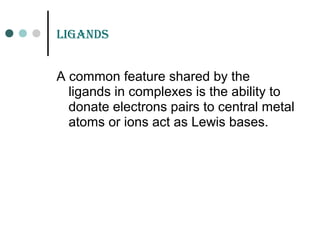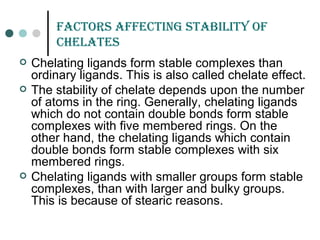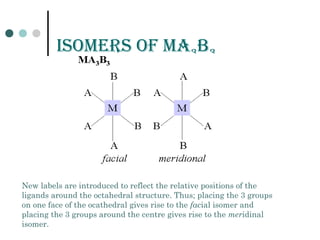This document provides an overview of coordination compounds. It begins by defining coordination compounds as those containing metal ions bonded to other neutral or negatively charged molecules by coordinate bonds. It then discusses various topics relating to coordination compounds, including Werner's theory of coordination chemistry, ligands, nomenclature, isomerism, and more. Key aspects covered include the defining characteristics and components of coordination compounds and complexes, common ligands, Werner's postulates explaining the electronic structure of complexes, and methods for naming coordination compounds according to IUPAC rules.






![CationiC ion
For positively charged complex ions
A positively charged complex ion is called
a cationic complex. A cation is a positively
charged ion.
Ni2
+
(aq) + 6NH3(aq) → [Ni(NH3)6]2
+
(aq)
Lewis acid Lewis base Complex ion](https://image.slidesharecdn.com/achapter3-221029172808-0da7193d/85/Coordination-compound-7-320.jpg)
![anioniC ion
For negatively charged complex
ions
A negatively charged complex ion is
called an anionic complex. An anion
is a negatively charged ion.
Fe3+
(aq) + 6CN-
(aq) → [Fe(CN)6]3-
(aq)
Lewis acid Lewis base Complex ion](https://image.slidesharecdn.com/achapter3-221029172808-0da7193d/85/Coordination-compound-8-320.jpg)



![CaLCuLation of CHarGE on CompLEX ion
[Fe(CN)6]3
-
Complex charge = sum of charges
on the metal and the ligands](https://image.slidesharecdn.com/achapter3-221029172808-0da7193d/85/Coordination-compound-12-320.jpg)
![[Fe(CN)6]3
-
Complex charge = sum of charges
on the metal and the ligands
+3 6(-1)
CaLCuLation of CHarGE on CompLEX
ion](https://image.slidesharecdn.com/achapter3-221029172808-0da7193d/85/Coordination-compound-13-320.jpg)
![[Co(NH3)6]Cl2
Neutral charge of coordination compound = sum of
charges on metal, ligands, and counterbalancing ions
neutral compound
CaLCuLation of CHarGE on CompLEX
ion](https://image.slidesharecdn.com/achapter3-221029172808-0da7193d/85/Coordination-compound-14-320.jpg)
![[Co(NH3)6]Cl2
+2 6(0) 2(-1)
Neutral charge of coordination compound = sum of
charges on metal, ligands, and counterbalancing ions
CaLCuLation of CHarGE on CompLEX
ion](https://image.slidesharecdn.com/achapter3-221029172808-0da7193d/85/Coordination-compound-15-320.jpg)


![formuLas of Coordination
Compounds
. Cation then anion
Total charges must balance to
zero
Complex ion in brackets
K2[Co(NH3)2Cl4]
[Co(NH3)4Cl2]Cl](https://image.slidesharecdn.com/achapter3-221029172808-0da7193d/85/Coordination-compound-18-320.jpg)
![Relating the Formula of a Complex to the Coordination
Number and Oxidation State of the Central Metal. What are
the coordination number and oxidation state of Co in the
complex ion [CoCl(NO2)(NH3)4]+
?
[CoCl(NO2)(NH3)4]+
oxidation state = x
charge of 1- on Cl -
charge of 1- on NO2
-
total
negative
charge: 2-
net charge on complex ion
x - 2 = +1
x = +3
coordination number = 6](https://image.slidesharecdn.com/achapter3-221029172808-0da7193d/85/Coordination-compound-19-320.jpg)

![Complex ion remains intact upon dissolution in water
[Co(NH3)6]Cl3 [Pt(NH3)4]Br2](https://image.slidesharecdn.com/achapter3-221029172808-0da7193d/85/Coordination-compound-21-320.jpg)












![Ionization of coordination compound (a) can be represented as
[Co(NH3)6]Cl3(s)
H2O
[Co(NH3)6]3
+
(aq) + 3 Cl-
(aq)
(a) yield three moles of AgCl(s) per mole of compound
In the presence of an excess of AgNO3(aq)
(b) yield only two moles of AgCl(s) per mole of compound
(c) and yield only one moles of AgCl(s) per mole of compound
[Co(NH3)6]Cl3
(a)
[CoCl2(NH3)4]Cl
(c)
[CoCl(NH3)5]Cl2
(b)
EXpLanation of CoordinatE Compounds on tHE
Basis of WErnEr’s tHEorY](https://image.slidesharecdn.com/achapter3-221029172808-0da7193d/85/Coordination-compound-34-320.jpg)

![WErnEr’s Coordination tHEorY and
isomErism
According to one of the postulates of Werner’s coordination theory, the secondary valencies determine the stereochemistry of the complexes.
L
L
X
X
L
L
Z
L
X
L
X
L
L
Z
Possible arrangements of the ligands in an octahedral
complex of composition [ZL4X2]
Werner also assigned two arrangements for this complex](https://image.slidesharecdn.com/achapter3-221029172808-0da7193d/85/Coordination-compound-36-320.jpg)








![naminG Coordination Compounds
1. In naming salts, the name of the cation is given before the
name of the anion.
For example, in [Co(NH3)5Cl]Cl2, we name [Co(NH3)5Cl]2
+
before
Cl-
.
2. Within a complex ion or molecule, the ligands are named
before the metal. Ligands are listed in alphabetical order,
regardless of charge on the ligand. Prefixes (see Rule #4
below) that give the number of ligands are NOT considered part
of the ligand name in determining alphabetical order.
Consider once again the [Co(NH3)5Cl]2
+
ion. Name the ammonia
ligand first, then the chloride, followed by the metal:
pentaamminechlorocobalt(III).](https://image.slidesharecdn.com/achapter3-221029172808-0da7193d/85/Coordination-compound-45-320.jpg)
![3. The names of the anionic ligands end in the letter “o”, whereas
neutral ones ordinarily bear the name of the molecules. Special
names are given for H2O (aqua), NH3 (ammine), CO (carbonyl), and
NO (nitrosyl).
For example, [Fe(CN)2(NH3)2(H2O)2]+
would be named
diamminediaquadicyanoiron(III) ion.
4. Greek prefixes (di, tri, tetra, penta, and hexa) are used to indicate
the number of each kind of ligand when more than one is present
as shown in the examples above. If the ligand already contains a
Greek prefix (as in ethylenediamine) or if it is polydentate (i.e. able
to attach at more than one binding site), then the following prefixes
are used instead:
2: bis- 3: tris- 4: tetrakis-](https://image.slidesharecdn.com/achapter3-221029172808-0da7193d/85/Coordination-compound-46-320.jpg)

![5. If the complex is an anion, its name ends in –ate. If the symbol of
the metal originates from a Latin name, then the Latin stem is used
instead
For example, the compound K4[Fe(CN)6] is named potassium
hexacyanoferrate(II).
Common Latin stem listings (in parentheses):
Copper (cuprate);
iron (ferrate);
tin (stannate);
lead (plumbate).
6. The oxidation number of the metal is given in parentheses in
Roman numerals directly following the name of the metal.](https://image.slidesharecdn.com/achapter3-221029172808-0da7193d/85/Coordination-compound-48-320.jpg)

![7. The coordination number of ligands attached to more than one
metal (bridging ligands) is indicated by a subscript to the
Greek symbol μ placed before the ligand name. This can be
illustrated by the following example
[(NH3)5Cr OH Cr(NH3)5]Cl5
μ-hydroxobis [pentaamminechromiun(III)] chloride
8. Geomatrical isomers are named by the use of the terms cis to
designate adjacent positions and trans to designate opposite
positions. For example, in square planar complexes the
positions 1,4 ; 1,2 ; 2,3 and 3,4 are cis while 1,3 and 2,4 are
trans with respect to each other](https://image.slidesharecdn.com/achapter3-221029172808-0da7193d/85/Coordination-compound-50-320.jpg)
![9.Optically active compounds are designated by the symbols
(+) or d- for dextro rotatory and (-) or l- for laevo rotatory.
d-K3[Ir(C2O4)2]
potassium (+) trioxalatoiridate(III)
For example ,](https://image.slidesharecdn.com/achapter3-221029172808-0da7193d/85/Coordination-compound-51-320.jpg)
![EXampLEs:
[NiCl4]2
− →
Tetrachloronickelate(II) ion
[CuNH3Cl5]3
− →
Amminepentachlorocuprate(II) ion
[Cd(en)2(CN)2] →
Dicyanobis(ethylenediamine)cadmium(II)
[Co(NH3)5Cl]SO4 →
Pentaamminechlorocobalt(III) sulphate](https://image.slidesharecdn.com/achapter3-221029172808-0da7193d/85/Coordination-compound-52-320.jpg)





![ioniZation isomErism
It arises due to the exchange of anion within and outside the
co-ordination sphere. As a result , these isomers give different
ions in solution.
Example:
[Co(NH3)5Br]SO4 SO4
--
anion in solution
violet
[Co(NH3)5SO4]Br Br-
anion in solution
red](https://image.slidesharecdn.com/achapter3-221029172808-0da7193d/85/Coordination-compound-58-320.jpg)

![ioniZation isomErism
Other Examples:
[PtBr(NH3)3]NO2 NO2
-
anions in
solution
[Pt(NH3)3(NO2)]Br Br-
anions in
solution](https://image.slidesharecdn.com/achapter3-221029172808-0da7193d/85/Coordination-compound-60-320.jpg)
![HYdratE isomErism
It arises when different number of water molecules are present inside
and outside the co-ordination sphere. This isomerism is illustrated by
the 3 isomers that have the formula CrCl3.6H2O
[CrCl2(H2O)4]Cl.2H2O [CrCl(H2O)5]Cl2.H2O [Cr(H2O)6]Cl3
These isomers have very different chemical properties and on
reaction with AgNO3 to test for Cl-
ions, would find 1, 2, and 3 Cl-
ions
in solution respectively.
These isomers can loose two, one and no water molecules on
dehydration with conc. sulphuric acid respectively](https://image.slidesharecdn.com/achapter3-221029172808-0da7193d/85/Coordination-compound-61-320.jpg)
![Coordination isomErism
It is observed in the co-ordination compounds having both cationic and anionic
complex ions. The ligands are interchanged in both the cationic and anionic ions to
form isomers.
For examples
1.
2.[Co(NH3)6] [Cr(C2O4)3] and [Co(C2O4)3] [Cr(NH3)6]](https://image.slidesharecdn.com/achapter3-221029172808-0da7193d/85/Coordination-compound-62-320.jpg)
![LinKaGE isomErism
Occurs in co-ordination compounds with ambidentate
ligands. These ligands are capable of coordinating in more
than one way. The best known cases involve the
monodentate ligands SCN-
/ NCS-
and NO2
-
/ ONO-
.
Examples:
[Co(NH3)5(ONO)]Cl2 the nitrito isomer -O attached
[Co(NH3)5(NO2)]Cl2 the nitro isomer - N attached.
[Co(NH3)5(NCS)]Cl2 Co-NCS isothiocyanate and
[Co(NH3)5(SCN)]Cl2 Co-SCN thiocyanate](https://image.slidesharecdn.com/achapter3-221029172808-0da7193d/85/Coordination-compound-63-320.jpg)




![GEomEtriCaL isomErism
It is due to ligands occupying different positions around the
central metal atom or ion
Also known as cis-trans isomerism .
Common in square planar and octahedral complexes but
not in tetrahedral complexes because all tetrahedral
complexes [such as Ma4 , Ma2b2 , Mabcd, where a,b,c,d
represents ligands ]exist in only one geometric form in which
all positions are adjacent to each other.
Existence of two different compounds having the molecular
formula [Pt(NH3)2Cl2] was used by the father of co-ordination
chemistry Alfred Werner to prove that transition metals often
have square planar geometries.](https://image.slidesharecdn.com/achapter3-221029172808-0da7193d/85/Coordination-compound-68-320.jpg)


![Example of Ma2b2 type compound
cis- and trans- isomers of [PtCl2(NH3)2]
pale orange yellow deep yellow
cis-[PtCl2(NH3)2 ]is an anti-cancer agent (cisplatin) whereas the trans- isomer
is inactive against cancer (it is toxic), and so not useful in Chemotherapy.
GEomEtriCaL isomErism in
sQuarE pLanEr Compounds](https://image.slidesharecdn.com/achapter3-221029172808-0da7193d/85/Coordination-compound-71-320.jpg)
![GEomEtriCaL isomErism in
sQuarE pLanEr Compounds
Isomers of Ma2bc
a a a c
M M
b c b a
cis trans
Example [Pt(NH3)2ClNO2]](https://image.slidesharecdn.com/achapter3-221029172808-0da7193d/85/Coordination-compound-72-320.jpg)
![GEomEtriCaL isomErism in
sQuarE pLanEr Compounds
Isomers of Mabcd
Example [Pt(NH3)(NH2OH)(NO2)(py)]NO2](https://image.slidesharecdn.com/achapter3-221029172808-0da7193d/85/Coordination-compound-73-320.jpg)
![GEomEtriCaL isomErism in
sQuarE pLanEr Compounds
Isomers of M(ab)2
Example : [Pt(gly)2] where gly is glycine
CH2 N NH2 CH2
Pt
CO O O CO
cis-
CO O NH2 CH2
Pt
CH2 N O CO
H2
trans-
H2](https://image.slidesharecdn.com/achapter3-221029172808-0da7193d/85/Coordination-compound-74-320.jpg)


![Example : [FeCl2(NH3)4]](https://image.slidesharecdn.com/achapter3-221029172808-0da7193d/85/Coordination-compound-77-320.jpg)

![Example : [Fe(NH3)3Cl3]](https://image.slidesharecdn.com/achapter3-221029172808-0da7193d/85/Coordination-compound-79-320.jpg)
![isomErs of maa2B2
Example: [Co(en)2Cl2]
where en is ethylene diamine bidentate ligand which
exists in cis- and trans- form.
cis- trans-](https://image.slidesharecdn.com/achapter3-221029172808-0da7193d/85/Coordination-compound-80-320.jpg)


![optiCaL isomErism in
oCtaHEdraL CompLEXEs
Octahedral complexes of the type [M(aa)3] ,
[ M(aa)2b2], [M(aa)b2x2] and [M(ab)3] show optical
isomerism.
Where;
aa is symmetrical bidentate ligand (e.g. en)
ab is unsymmetrical bidentate ligand (e.g. gly)
b,x is monodentate ligand](https://image.slidesharecdn.com/achapter3-221029172808-0da7193d/85/Coordination-compound-83-320.jpg)
![ Isomer of M(aa)3
Example: [Co(en)3]Cl3
d form l form](https://image.slidesharecdn.com/achapter3-221029172808-0da7193d/85/Coordination-compound-84-320.jpg)
![ Isomers of M(aa)2b2
Example [Co(en)2Cl2]+
cis-d-isomer cis-l-isomer
Trans-form of the above compound does not show
optical isomerism because it has plane of symmetry](https://image.slidesharecdn.com/achapter3-221029172808-0da7193d/85/Coordination-compound-85-320.jpg)


![The EAN rule is helpful for organometallic compounds and
carbonyl complexes, which obey in most cases this rule:
[Cr(CO)6] [Fe(CO)5] [Ni(CO)4]
Cr 24 e-
Fe 26 e-
Ni 28 e-
6CO 12 e-
5CO 10 e-
4CO 8 e-
36 e-
36 e-
36 e-](https://image.slidesharecdn.com/achapter3-221029172808-0da7193d/85/Coordination-compound-88-320.jpg)
![Similarly the formation of olefin complexes and
metallocenes may be explained by the EAN rule:
olefines donate 2 electrons /double bond
ethylene 2
butadiene 4
benzene 6
cyclopentadienyl radical 5
[Fe(C5H5)2] [Mn(CO)5C2H4]+
[Cr(C6H6)2]
Fe 26 Mn+ 24 Cr 24
2 C5H5· 10 5 CO 10 2 C6H6 12
36 C2H4 2 36
36](https://image.slidesharecdn.com/achapter3-221029172808-0da7193d/85/Coordination-compound-89-320.jpg)
![Examples:
[Co(NO2)6]3
-
[PtCl6]2
-
[Ag(NH3)4]+
Co3
+
24 e-
Pt4
+
74 e-
Ag+
46 e-
6NO2
-
12 e-
6Cl-
12 e-
4NH3 8 e-
36 e-
86 e-
54 e-
but
[Cr(NH3)6]3
+
[Ni(NH3)6]2
+
[CoCl4]2
-
Cr3
+
21 e-
Ni2
+
26 e-
Co2
+
25 e-
6NH3 12 e-
6NH3 12 e-
4Cl-
8 e-
33 e-
38 e-
33 e-
Many elements form complexes which do not obey the](https://image.slidesharecdn.com/achapter3-221029172808-0da7193d/85/Coordination-compound-90-320.jpg)









![Valence Bond Theory
Example 1: [Co(NH3)6]3+
Co [Ar] 3d7
4s2
Co3+
[Ar] 3d6
3d 4s 4p
if complex is diamagnetic
4d
d2
sp3
octahedral
:
appLiCations of vaLEnCE Bond tHEorY](https://image.slidesharecdn.com/achapter3-221029172808-0da7193d/85/Coordination-compound-100-320.jpg)
![Valence Bond Theory
Example 2: [CoF6]3–
Co [Ar] 3d7
4s2
Co3+
[Ar] 3d6
if complex is paramagnetic
3d 4s 4p 4d
4sp3
d2
octahedral](https://image.slidesharecdn.com/achapter3-221029172808-0da7193d/85/Coordination-compound-101-320.jpg)
![Valence Bond Theory
Example 3: [PtCl4]2–
, diamagnetic
Pt2+
[Xe] 4f14
5d8
5d 6s 6p
dsp2
square planar](https://image.slidesharecdn.com/achapter3-221029172808-0da7193d/85/Coordination-compound-102-320.jpg)
![Valence Bond Theory
Example 4: [NiCl4]2–
, tetrahedral
Ni2+
[Ar] 3d8
3d 4s 4p
4sp3
paramagnetic](https://image.slidesharecdn.com/achapter3-221029172808-0da7193d/85/Coordination-compound-103-320.jpg)
![Hybrid orbitals and bonding in the octahedral [Cr(NH3)6]3
+
ion.](https://image.slidesharecdn.com/achapter3-221029172808-0da7193d/85/Coordination-compound-104-320.jpg)
![Hybrid orbitals and bonding in the square planar [Ni(CN)4]2
-
ion
The 3d metal electrons are unhybridized thus diamagnetic
and the ligand electrons fit into the leftover hybridized dsp2
orbitals of the metal. CN=4 and square planar.](https://image.slidesharecdn.com/achapter3-221029172808-0da7193d/85/Coordination-compound-105-320.jpg)
![Hybrid orbitals and bonding in the tetrahedral [Zn(OH)4]2
-
ion.](https://image.slidesharecdn.com/achapter3-221029172808-0da7193d/85/Coordination-compound-106-320.jpg)
